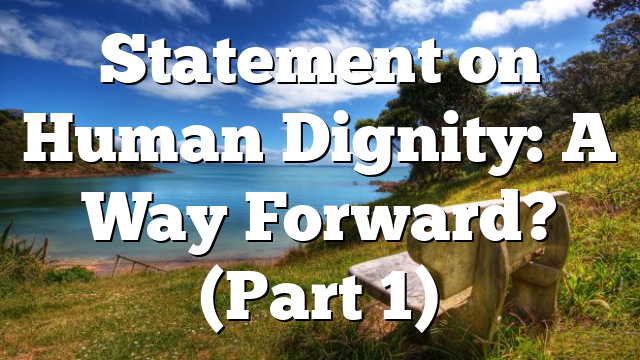Click to join the conversation with over 500,000 Pentecostal believers and scholars
Click to get our FREE MOBILE APP and stay connected
| PentecostalTheology.com



Dale M. Coulter
In previous posts, I have argued that resolutions and adding more conditions to the instructions for ministers are not the best way to address the cultural challenges of the day. Instead, the Church of God Executive Committee should work with the doctrine and polity committee to formulate responses. Today and tomorrow, I will offer a draft of what a statement might look like in response to the issue of transgenderism.
Statement on Human Dignity: Part I
From the beginning of the movement, the Church of God has sought to uphold the dignity of all persons in concert with the commandment to neighbor love (Matt. 22:39; Mark 12:31). As part of fulfilling its mission, the Church of God has dedicated itself to care of the whole person as a core value. “We commit ourselves to the challenge of being a church that genuinely cares for one another and for those who are lost, hurting, and needy” (Minutes, Commitments to Our Mission and Vision, 6). The Church of God fulfills this mission by declaring the gospel in word and deed for the sake of the world.
The church proclaims the gospel by seeking always to abide in the truth through love. To fulfill its mission, the church must never separate its actions from its declarations. It must always live in the truth. For the Church of God, this means a commitment to the verbal inspiration of scripture and to the whole Bible rightly divided with the New Testament as its rule of faith.
Over the past few decades, new challenges have emerged that challenge the fundamental dignity of the human person. In the face of these challenges, this statement seeks to set forth the truth of scripture in concert with basic insights from science and other human disciplines. The Church of God holds that all truth is God’s truth and thus scripture and science together testify to the truth about the human person and creation.
Because human freedom is ordered toward the truth, love is always be the context within which the truth beckons the person to follow. “For God so loved the world that he gave his only-begotten Son” (John 3:16). The love of God calls out to freedom in a way that preserves human dignity and elevates the person into a holy life.
The Church of God seeks to live out this commitment to a holy love that abides in the truth through its core values of world evangelization and care as well as its practical commitments to marriage, the family, the sanctity of life, and correcting social injustices. It is with these in mind that this statement addresses the challenge to human dignity by contemporary reductionist accounts that devalue the spiritual or bodily dimension of the human person.
Human Dignity and the Image of God
Humans fully image God in their whole person (Gen. 1:27). God’s forming humanity from the dust and breathing in them the breath of life means that the entire human person is God’s workmanship (Gen. 2:7; Eph. 2:10). This image cannot be reduced to a specific set of attributes such as cognitive abilities. To do so is to deny full personhood to the baby in the womb, the Down’s syndrome child, or those facing end-of-life decisions. The image of God flows from the body-soul unity of the person. Human persons fully reflect God in their wholeness.
The dignity of the person shines through in freedom of conscience upon which freedom of religion is grounded. Out of the fullness of triune love for the world, the Father sent his Son to be crucified for us and poured out his Spirit upon us for our salvation. As both reflections of and participants in this divine love through their freedom, the dignity of human persons shines forth. This dignity is inviolable.
By making humanity out of dust and placing the original humans in a garden, God reveals the fundamental connection between human persons and creation. Humanity is rooted in and relationally bound to the created world. This biblical truth is confirmed by what science reveals about the interconnections among environments and ecosystems. Life is fundamentally relational.
The dignity of the human person participates in a fundamental order in creation that reflects the moral law of God. Grounded in the nature of God, this order is also expressed in the natural law written upon the heart (Rom. 2:15). As a reflection of this order, human persons were made for relationship with God, one another, and creation itself. Male and female together image God in their full equality, complementarity, and relationality.
Since the image of God exists in the whole person, body and soul, human bodies are also called temples of God capable of glorifying God (1 Cor. 6:19-20). In the Church of God Practical Commitments, it states, “Our body is the temple of the Holy Ghost, and we are to glorify God in our body (Romans 12:1, 2; 1 Corinthians 6:19, 20; 10:31).” Following the order of creation, salvation includes the resurrection and transformation of the body as well as the soul (1 Cor. 15:35-49).
Through this body-soul unity, human persons share both in creation and in God. Human freedom finds its highest expression in orienting the person toward the truth about the body and the soul. This means that human dignity is preserved as human persons live and abide in the truth found in scripture and confirmed by creation.
Human Dignity, the Body, and Marriage
The human body is sexed at conception as determined by the presence or absence of a Y sex chromosome. The sexual pattern in the inherited genetic material gives rise to biological differences between male and female. Sex is not assigned, but recognized in the organization of the body, especially in relation to sexual union and procreation (as even the grainy ultrasound picture of a child in the womb indicates).
This bodily differentiation into male and female sex begins in the womb and continues through puberty. It results in distinctive reproductive organs, hormones, and even secondary characteristics such as body size, bone length and density, fat distribution, and other differences. Such biological differences between men and women mean that sexual identity is stable and binary. Disorders of sexual development do not constitute a third sex or abrogate the division into male and female.
This order in creation includes the good of the biological sex of the person and the good of the sexual act within the context of marriage between male and female. In marriage, man and woman become one flesh in procreative and relational union (Gen. 2:24; Matt. 19:6; Mark 10:8). The husband and wife express both the image of God and the relationship between Christ and his church in this union (Eph. 5:22-33). Even couples who cannot have children still express this comprehensive and permanent union in their minds and bodies.
While marriage between husband and wife is one good of creation, some are called to a life of singleness and sacrifice in imitation of Christ. This calling is also a good. Just as marriage is a calling in which God joins husband and wife by gifting each, so singleness is also a calling and a gift. Paul declares, “Each one has his own gift from God, one in this manner and another in that” (1 Cor. 7:7). Within the church, the married and the single together live out their respective callings in love and holiness.
The whole counsel of God teaches that humans image God as whole persons who are in relationship with God, one another, and creation. In this way, human persons reflect the inner dynamic of Father, Son, and Holy Spirit. The Father, Son, and Holy Spirit are fully equal and abide in one another so that they are one God. The purpose of the division into male and female is to show how God has ordered the body and the soul to reflect the complementarity, equality, and relationality of the image of God. This is particularly expressed in the comprehensive union of husband and wife. This union involves a union of hearts by their love and a union of bodies by the sexual act.
*Part II Coming Tomorrow


